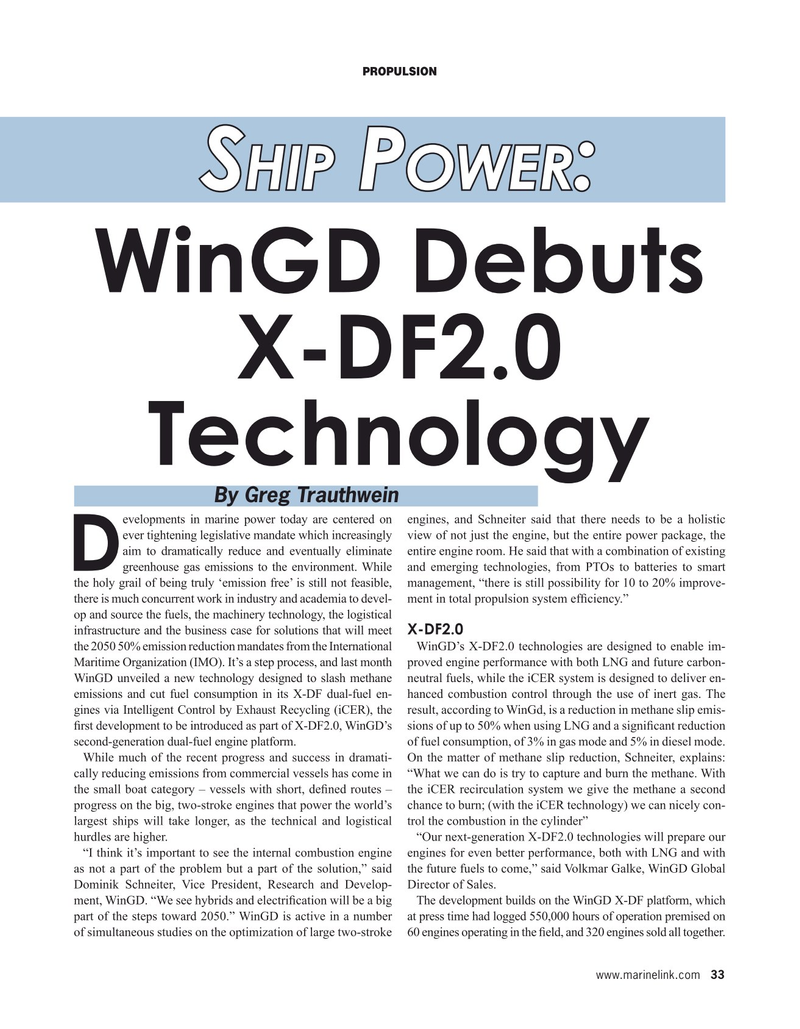
Page 33: of Maritime Reporter Magazine (July 2020)
Maritime Power Edition
Read this page in Pdf, Flash or Html5 edition of July 2020 Maritime Reporter Magazine
PRoPulsIoN
S p : hip ower
WinGD Debuts
X-DF2.0
Technology
By Greg Trauthwein evelopments in marine power today are centered on engines, and Schneiter said that there needs to be a holistic ever tightening legislative mandate which increasingly view of not just the engine, but the entire power package, the aim to dramatically reduce and eventually eliminate entire engine room. He said that with a combination of existing
Dgreenhouse gas emissions to the environment. While and emerging technologies, from PTOs to batteries to smart the holy grail of being truly ‘emission free’ is still not feasible, management, “there is still possibility for 10 to 20% improve- there is much concurrent work in industry and academia to devel- ment in total propulsion system effciency.” op and source the fuels, the machinery technology, the logistical infrastructure and the business case for solutions that will meet X-DF2.0 the 2050 50% emission reduction mandates from the International WinGD’s X-DF2.0 technologies are designed to enable im-
Maritime Organization (IMO). It’s a step process, and last month proved engine performance with both LNG and future carbon-
WinGD unveiled a new technology designed to slash methane neutral fuels, while the iCER system is designed to deliver en- emissions and cut fuel consumption in its X-DF dual-fuel en- hanced combustion control through the use of inert gas. The gines via Intelligent Control by Exhaust Recycling (iCER), the result, according to WinGd, is a reduction in methane slip emis- frst development to be introduced as part of X-DF2.0, WinGD’s sions of up to 50% when using LNG and a signifcant reduction second-generation dual-fuel engine platform. of fuel consumption, of 3% in gas mode and 5% in diesel mode.
While much of the recent progress and success in dramati- On the matter of methane slip reduction, Schneiter, explains: cally reducing emissions from commercial vessels has come in “What we can do is try to capture and burn the methane. With the small boat category – vessels with short, defned routes – the iCER recirculation system we give the methane a second progress on the big, two-stroke engines that power the world’s chance to burn; (with the iCER technology) we can nicely con- largest ships will take longer, as the technical and logistical trol the combustion in the cylinder” hurdles are higher. “Our next-generation X-DF2.0 technologies will prepare our “I think it’s important to see the internal combustion engine engines for even better performance, both with LNG and with as not a part of the problem but a part of the solution,” said the future fuels to come,” said Volkmar Galke, WinGD Global
Dominik Schneiter, Vice President, Research and Develop- Director of Sales.
ment, WinGD. “We see hybrids and electrifcation will be a big The development builds on the WinGD X-DF platform, which part of the steps toward 2050.” WinGD is active in a number at press time had logged 550,000 hours of operation premised on of simultaneous studies on the optimization of large two-stroke 60 engines operating in the feld, and 320 engines sold all together.
www.marinelink.com 33

 32
32

 34
34
